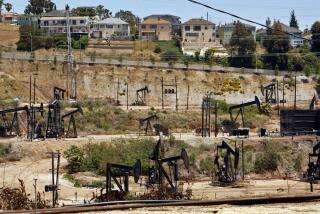REGIONAL OUTLOOK / OIL PATCH : Back From Bust: Texas on Mend, Others Languish : Houston leads a robust recovery by diversifying. A plunge in petroleum prices like that in ’86 no longer need cripple the whole area.
- Share via
HOUSTON — Texas, Oklahoma and Louisiana, all heavily dependent on oil to keep their coffers full, watched in disbelief as crude prices tumbled to a low of $10 a barrel in 1986, crippling the states’ economies and ruining lives.
Things are a bit better these days. But like a garden that has been unevenly watered, some cities and regions are making a relatively robust comeback while others are not.
Houston is prospering while New Orleans is hurting. That kind of inconsistent recovery seems to be the emerging pattern for the oil-patch states in the coming decade.
Of the three states, Texas is reviving most quickly. A recent report by Bob Bullock, the state’s comptroller, predicted that Texas would trail only California in population by the year 2000.
He also estimated there would be 1.5 million new jobs by the end of the millennium. More people moved to Texas than left it last year, reversing a two-year trend.
And leading the way is Texas’ largest city, Houston, which until two years ago was stuck in a financial quagmire. At one point, housing values fell by 30% or more as those who had come during the boom times left in droves, leaving whole neighborhoods empty.
But a new study by the University of Houston reported that home values here increased more than 10% last year and should shoot up almost 13% more during 1990. Part of the reason is that an estimated 40% of the new jobs added to the Texas economy in the last two years have been in Houston and neighboring Galveston.
“Houston’s growth has just been incredible,” said Barton Smith, the author of the study and chairman of the University of Houston economics department.
The most recent survey put Houston’s unemployment at 4.6%, the lowest it has been in eight years. Dallas is undergoing a similar boom, which is fueled like Houston’s by a move to a more diversified economy.
“Houston and Dallas have benefited at the expense of Tulsa and New Orleans,” said Bernard Weinstein, director of the Center for Economic Development and Research at the University of North Texas.
Overall, the movement of major corporations into Texas has allowed the state to reduce its dependence on oil revenues to a point where even a drastic reduction in the price of petroleum will no longer spell ruination of the overall economy.
Bullock said oil and gas accounted for 15% of the state’s economic output last year compared to 27% in 1981, the peak of the oil boom.
But the effect has been uneven. West Texas cities such as Midland and Odessa, where oil is still the economic linchpin, “could end up like the precious-metals cities of California, Colorado and Alaska” if they don’t diversify soon, said Prof. Smith.
The same might be said of wide swaths of Louisiana, which “makes Texas look like heaven,” said Doug Ross of the Washington-based Corporation for Enterprise Development. Louisiana is “kind of the sick man of America,” he said.
How the state will solve its problems is anybody’s guess. The voters have made it clear that they want no new taxes, even though oil money financed virtually every aspect of government programs in Louisiana. Louisiana’s reform governor, Buddy Roemer, has had some rough sledding in this state where feeding at the public trough had become a way of life.
But the oil bust has spurred some rather unexpected developments. With the influence of big oil on the wane, the environmental movement in Louisiana has become stronger, and for the first time tougher laws are being passed to prevent the petrochemical industry pollution that has devastated the Mississippi River and the state’s wetlands.
And in Oklahoma, the bust has brought home the need to place more emphasis on education, with the realization that the future is going to depend not on Oklahoma crude, but innovation and brainpower. The state Legislature recently passed a bill to beef up the school system with an eye toward developing a more diversified work force.
Throughout the oil patch, wariness now greets ventures that promise great wealth and great risk. The commercial real estate market is glutted with buildings that went up willy-nilly during the boom years. The bankers who made those loans, then later had to foreclose on the bad ones, now shy away from any deals that even vaguely smack of speculation.
So what’s to become of the oil patch? Diversification is a common buzz word. Weinstein added that natural gas, with years of reserves, will remain a mainstay. But “the future of the oil patch isn’t oil,” he said. “The oil plays are pretty much over.”
More to Read
Sign up for Essential California
The most important California stories and recommendations in your inbox every morning.
You may occasionally receive promotional content from the Los Angeles Times.










